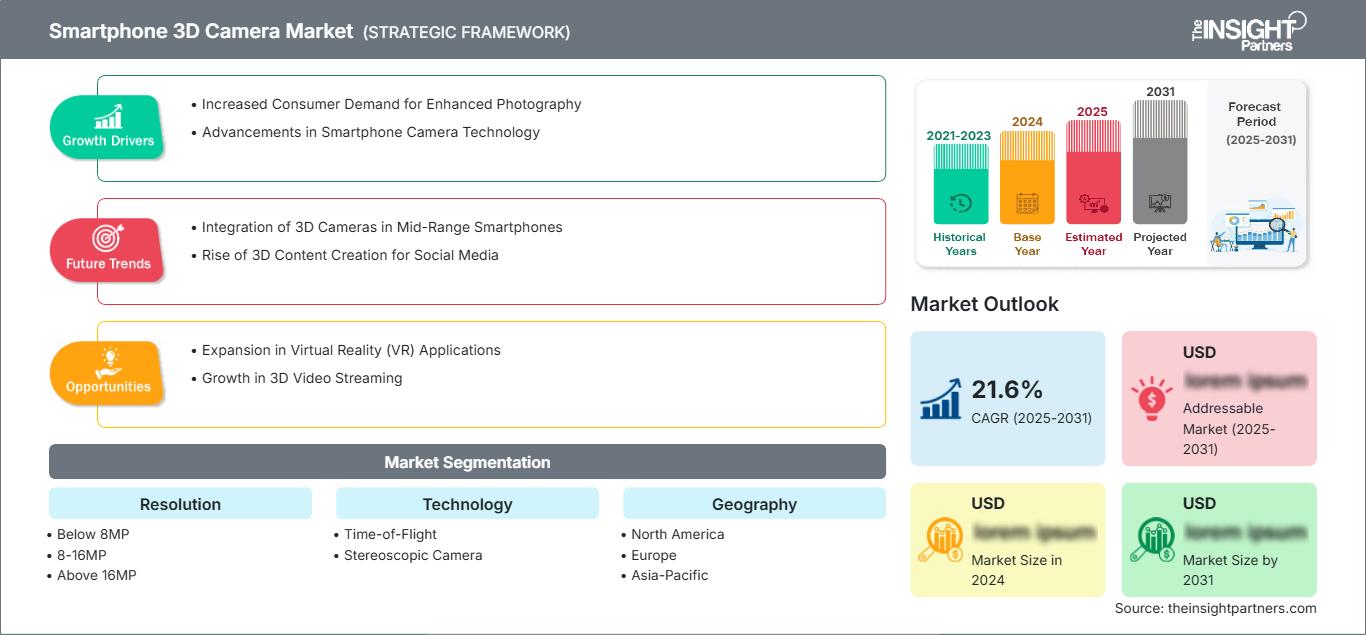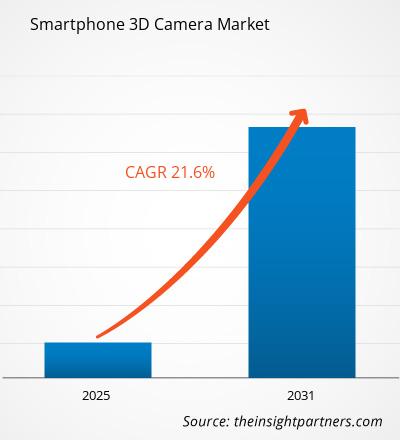页面已更新 :
Jan 2025
预计智能手机 3D 相机市场在 2025 年至 2031 年期间的复合年增长率为 21.6%,市场规模将从 2024 年的 XX 百万美元扩大到 2031 年的 XX 百万美元。
该报告按分辨率(低于 8MP、8-16MP、高于 16MP)、技术(飞行时间 (TOF)、立体相机)进行细分。全球分析进一步细分为区域和主要国家。该报告以美元提供了上述分析和细分的价值。
报告目的
Insight Partners 撰写的《智能手机 3D 相机市场》报告旨在描述当前形势和未来增长、主要驱动因素、挑战和机遇。这将为各种业务利益相关者提供见解,例如:
- 技术提供商/制造商:了解不断变化的市场动态并了解潜在的增长机会,使他们能够做出明智的战略决策。
- 投资者:对市场增长率、市场财务预测和整个价值链中存在的机会进行全面的趋势分析。
- 监管机构:规范市场政策和警察活动,旨在最大限度地减少滥用,维护投资者的信任和信心,并维护市场的完整性和稳定性。
智能手机 3D 相机市场细分分辨率
- 低于 8MP
- 8-16MP
- 高于 16MP
技术
- 飞行时间
- 立体相机
自定义此报告以满足您的要求
您将免费获得任何报告的定制,包括本报告的部分内容,或国家级分析、Excel 数据包,以及为初创企业和大学提供超值优惠和折扣
智能手机3D相机市场: 战略洞察

- 获取本报告的主要市场趋势。这个免费样本将包括数据分析,从市场趋势到估计和预测。
智能手机 3D 相机市场增长动力
- 消费者对增强摄影功能的需求不断增长:消费者对包括 3D 摄影在内的高级相机功能日益增长的偏好,是智能手机 3D 相机市场的主要驱动力。用户正在寻求更具沉浸感和动态的成像功能,以满足个人和专业用途,从而推动智能手机对 3D 相机的采用率不断提高。
- 智能手机相机技术的进步:智能手机相机系统的技术进步,例如镜头、传感器和人工智能的改进,正在推动智能手机 3D 相机市场的发展。这些创新使智能手机能够捕捉高质量的 3D 图像和视频,为制造商提供了竞争优势,并吸引了寻求尖端摄影功能的消费者。
智能手机 3D 相机市场未来趋势
- 3D 相机集成到中端智能手机:3D 相机以前仅限于高端设备,现在也已集成到中端智能手机中。这一趋势正在普及高级成像功能,拓宽 3D 相机市场,使其覆盖更广泛的消费者群体。
- 社交媒体 3D 内容创作的兴起:随着社交媒体平台影响力的不断增强,3D 内容创作也呈现日益增长的趋势。智能手机用户正在利用 3D 摄像头为 Instagram、TikTok 和 YouTube 等平台创建更具吸引力和互动性的照片和视频,从而推动了对支持 3D 功能的智能手机的需求。
智能手机 3D 摄像头市场机遇
- 虚拟现实 (VR) 应用的扩展:随着虚拟现实 (VR) 的普及,智能手机 3D 摄像头带来了巨大的机遇。3D 摄像头可以捕捉沉浸式内容,从而增强 VR 体验。制造商可以利用这一点,开发配备先进 3D 摄像头的智能手机,用于以 VR 为中心的应用,包括游戏、模拟和培训。
- 3D 视频流的增长:人们对 3D 视频流(包括 3D 电影和沉浸式视频)的兴趣日益浓厚,为智能手机 3D 摄像头市场带来了重大机遇。随着流媒体服务和平台扩展其 3D 内容产品,配备 3D 摄像头的智能手机将成为寻求体验高质量 3D 媒体的消费者的必备之物。
智能手机 3D 相机市场区域洞察
The Insight Partners 的分析师已详尽阐述了预测期内影响智能手机 3D 相机市场的区域趋势和因素。本节还讨论了北美、欧洲、亚太地区、中东和非洲以及南美和中美洲的智能手机 3D 相机市场细分和地域分布。
智能手机 3D 相机市场报告范围
| 报告属性 | 细节 |
|---|---|
| 市场规模 2024 | US$ XX million |
| 市场规模 2031 | US$ XX Million |
| 全球复合年增长率 (2025 - 2031) | 21.6% |
| 历史数据 | 2021-2023 |
| 预测期 | 2025-2031 |
| 涵盖的领域 |
By 分辨率
|
| 覆盖地区和国家 | 北美
|
| 市场领导者和主要公司简介 |
|
智能手机 3D 相机市场参与者密度:了解其对业务动态的影响
智能手机 3D 相机市场正在快速增长,这得益于终端用户需求的不断增长,而这些需求的驱动因素包括消费者偏好的不断变化、技术进步以及对产品优势的认知度不断提高。随着需求的增长,企业正在扩展其产品线,不断创新以满足消费者需求,并抓住新兴趋势,从而进一步推动市场增长。

- 获取 智能手机3D相机市场 主要参与者概述
主要卖点
- 全面覆盖:本报告全面涵盖了对智能手机3D相机市场的产品、服务、类型和最终用户的分析,提供了整体格局。
- 专家分析:本报告基于对行业专家和分析师的深入了解而编写。
- 最新信息:由于涵盖了最新信息和数据趋势,本报告确保了业务相关性。
- 定制选项:本报告可以根据特定客户要求进行定制,并恰如其分地适应业务策略。
因此,智能手机3D相机市场研究报告有助于引领解读和理解行业情景和增长前景的步伐。尽管可能存在一些合理的担忧,但本报告的总体优势往往大于劣势。
- 历史分析(2 年)、基准年、预测(7 年)及复合年增长率
- PEST和SWOT分析
- 市场规模、价值/数量 - 全球、区域、国家
- 行业和竞争格局
- Excel 数据集
近期报告
相关报告
客户评价
购买理由
- 明智的决策
- 了解市场动态
- 竞争分析
- 客户洞察
- 市场预测
- 风险规避
- 战略规划
- 投资论证
- 识别新兴市场
- 优化营销策略
- 提升运营效率
- 顺应监管趋势
我们的客户































87-673-9708

ISO 9001:2015



 获取免费样品 - 智能手机3D相机市场
获取免费样品 - 智能手机3D相机市场